Photosynthesis Campbell and Reece Chapter 10 Autotrophs selffeeders

Photosynthesis Campbell and Reece Chapter 10

Autotrophs • “self-feeders” • sustain themselves w/out eating anything derived from other living things • are the biosphere’s producers • photoautotrophs: plants, algae, some protists, & some prokaryotes

Heterotrophs • live on cpds produced by other organisms • are the biosphere’s consumers • Includes: carnivores, omnivores, decomposers

Origin of Photosynthesis • Photosynthesis most likely originated in prokaryotes that had infolded regions of plasma membrane containing clusters of that included photosystems and photosynthetic enzymes

Chloroplasts • All green parts of plants have chloroplasts but leaves are major sites of photosynthesis in most plants • 1 mm² of top of a leaf contains. 5 million chloroplasts!

Parts of a Leaf

Parts of a Leaf • Mesophyll: leaf cells specialized for photosynthesis • Stomata: microscopic pore surrounded by guard cells in epidermis of leaf & stems, allows gas exchange • Veins: vascular bundle in a leaf

Chloroplast Structure • ~2 -4 μm by 4 -7 μm • dbl membrane surrounding dense fluid called the stroma • membrane w/in stroma made of sacs called thylakoids • inside thylakoid: thylakoid space • Chlorophyll & photosystems reside in thylakoid membrane

Chloroplast Structure

Photosynthesis Equation • equation worked out in 19 th century • use glucose as product to simplify relationship with respiration but what actually happens….

Photosynthesis Equation • direct product is 3 -C sugar that can be used to make glucose • light • CO 2 + H 2 O [CH 2 O] + O 2
![Photosynthesis Equation • [CH 2 O] brackets mean what is inside is not actual Photosynthesis Equation • [CH 2 O] brackets mean what is inside is not actual](http://slidetodoc.com/presentation_image_h/33273057e2979d049f601f03163ef794/image-12.jpg)
Photosynthesis Equation • [CH 2 O] brackets mean what is inside is not actual sugar but represents general formula for carbohydrate (building a carbohydrate 1 carbon at a time)

Photosynthesis Equation • originally, it was thought the O 2 released came from CO 2 • assumption challenged in 1930’s (van Niel, Stanford University) – Studied bacteria that use CO 2 to make carbohydrates but do not release O 2 – Concluded that at least in the bacteria he studied CO 2 was not split

Photosynthesis Equation • Another group bacteria use H 2 S (hydrogen sulfide) instead of water releasing S: • CO 2 + 2 H 2 S [CH 2 O] + H 2 O + 2 S • van. Niel concluded the H 2 S split & H was used with C to build sugars & inferred water must split in photosynthesis with H to sugars & O released

Photosynthesis Equation • Van Niel’s hypothesis confirmed in 1950’s when O-18 used in water and traced thru photosynthesis

Photosynthesis as Redox Reactions • photosynthesis equation: C becomes reduced & O oxidized

Summary of Photosynthesis

Photosynthesis Vocabulary • Photophosphorylation: process of generating ATP from ADP + P by means of chemiosmosis using a proton-motive force generated across the thylakoid membrane • Carbon Fixation: incorporation of C from CO 2 into an organic cpd by an autotroph


Light Reactions

Light • Form of electromagnetic energy or radiation • 380 nm – 750 nm = visible light • Photon: discrete particle of energy – Amt nrg inversely proportional to wavelength

Electromagnetic Spectrum

Photosynthesis Pigments • pigment substance that absorbs light – different pigments absorb different wavelengths – we see color that is reflected (not absorbed) – Chlorophyll absorbs violet-blue & red

Spectrophotometer • Measures the proportion of light of different wavelengths absorbed & transmitted by a pigment solution

Absorption Spectrum • graph plotting a pigment’s light absorption versus wavelength

Chlorophyll’s Absorption Spectrum • gives clues to relative effectiveness of different wavelengths for driving photosynthesis (light can perform work in chloroplasts only if it is absorbed)

Pigments in Photosynthesis • chlorophyll a – Violet-blue & red light works best – appear blue green • chlorophyll b – violet blue – appear olive green • carotenoids – violet & blue-green – appear various shades yellow & orange

Chlorophyll a/b

Rate of Photosynthesis vs. Wavelength of Light

Carotenoids • absorb wavelengths that chlorophylls do not • more importantly they function as photoprotection: they absorb & dissipate light nrg that would otherwise damage chlorophyll or would interact with O 2 yielding reactive oxidative products that would damage cell (act as antioxidants)

Phytochemicals • carotenoids in health food products • promoted as antioxidants

What Happens When Chlorophyll Absorbs Light ? • colors from corresponding wavelengths that are absorbed disappear from the spectrum of transmitted & reflected light • but nrg cannot disappear

What Happens When Chlorophyll Absorbs Light? • nrg from photon absorbed by e- in pigment (more nrg. . e- moves to orbital further out from nucleus where it has more PE & less stability) • ground state: when e- in normal orbital • excited state: e- in orbital of higher nrg

Which Photons are Absorbed? • only those photons whose wavelength’s nrg is exactly = to the nrg difference between the ground & excited states • explains why each pigment has unique absorption spectrum

Electrons in the Excited State • unstable when excited • if isolated: chlorophyll molecules absorb photons the e- immediately drop back to ground state releasing nrg as heat or light (fluorescence) & heat

Excitation of Isolated Chlorophyll Molecule

Photosystems • chlorophyll molecules in native state found in thylakoid membrane organized into complexes called photosystems

Photosystem • composed of: 1. Reaction-Center Complex surrounded by: 2. Light-Harvesting Complex – consists of various pigments bound to proteins: – chlorophyll a – chlorophyll b – carotenoids

Photosystems • Light-Harvesting Complex acts like “antennae” for the Reaction-Center Complex

Reaction-Center Complex • contains molecule (the primary eacceptor) capable of accepting e- & becoming reduced

1 st Step of Light Reactions • solar-powered transfer of e- from reaction-center chlorophyll a primary e- acceptor • redox reaction

2 Types of Photosystems • PS II – It’s reaction-center complex known as P 680 – 680 wavelength in red part of spectrum • PS I – It’s reaction-center complex known as P 700 – 700 wavelength far red part of spectrum

P 680 & P 700 both Chlorophyll a

Linear Electron Flow

Linear e- Flow Figure 10. 14 • 1. photon strikes PS II chlorophyll a & 1 e- jumps to higher nrg level -> this e- falls back to its ground state transferring its nrg to nearby chlorophyll molecule so 1 of its ejump to excited state …. . continues like this until it reaches P 680 pair of chlorophyll a molecules in reactioncenter & a pair of e- jumps to excited state

Linear Electron Flow: Figure 10. 14

Linear Electron Flow: Figure 10. 14 Step 2: e- transferred from excited P 680 primary e- acceptor making P 680+

Linear Electron Flow: Figure 10. 14

Linear Electron Flow: Figure 10. 14 Step 3: enzyme splits 2 water 4 e+ 4 H+ + O 2 2 e- replace those that left P 680 so P 680+ returns to P 680 one of strongest biological oxidizing agents H+ released into thylakoid space O 2 diffuses out of chloroplast out of cell

Linear Electron Flow: Figure 10. 14


http: //highered. mcgrawhill. com/olcweb/cgi/pluginpop. cgi? it=swf: : 535: : /sites/dl/free/0072437316/120072/bio 13. swf: : Photosynthetic%20 Electron%20 Transp ort%20 and%20 ATP%20 Synthesis http: //www. science. smith. edu/departments/Bi ology/Bio 231/ltrxn. html http: //bcs. whfreeman. com/thelifewire/content/ chp 08/0802002. html

Linear Electron Flow: Figure 10. 14 Step 4: excited e- from PSII PS I thru e- transport chain between PS II and PS I e- carrier plastoquinone (Pq), a cytochrome complex, & a protein called plastocyanin (Pc)

Linear Electron Flow: Figure 10. 14

Linear Electron Flow: Figure 10. 14 Step 5: as e- pass thru cytochrome complex, H+ are pumped into the thylakoid lumen, building H+ gradient (later used in chemiosmosis)

Linear Electron Flow: Figure 10. 14

Linear Electron Flow: Figure 10. 14 Step 6: also happening: photons absorbed by PS I reaction center complex exciting e- of P 700 pair of chlorophyll a molecules photoexcited e- PS I e- acceptor creating “e- hole” in P 700+ gets e- from bottom of etransport chain that started @ PS II

Linear Electron Flow: Figure 10. 14

Linear Electron Flow: Figure 10. 14 Step 7: photoexcited e- from PS I passed thru series of redox reactions down 2 nd e- transport chain thru the protein ferrodoxin (Fd) this 2 nd chain does not add to H+ gradient & does not make ATP

Linear Electron Flow: Figure 10. 14

Linear Electron Flow: Figure 10. 14 Step 8: enzyme NADP+ reductase catalyzes transfer of 2 e- from Fd NADP+ + H+ (from stroma) NADPH

NADPH provides reducing power in the Calvin Cycle NADP+ NADPH

Cyclic Electron Flow • Only uses PS I • e- cycle back from Fd Cytochrome complex P 700 • no NADPH • no release of O 2 • + generation of ATP (supplements supply of ATP)

Cyclic Electron Flow

Cyclic Electron Flow • used by some photosynthetic bacteria • only have PS I • evolutionary biologists: these bacteria descendants of bacteria in which photosynthesis 1 st evolved – ex: purple sulfur bacteria

Cyclic Electron Flow • also can occur in photosynthetic species with both PS II and PS I • ex: cyanobacteria, eukaryotic photosynthetic species • at least 1 benefit: mutant plants that cannot carry out cyclic e- flow grow well only in low light; do not grow well in intense light …. So cyclic e- flow must have a photoprotective role

Chemiosmosis • exact same basic mechanism used in chloroplasts & mitochondria: e- transport chain in a membrane actively pumps protons (H+) across it while e- move thru series of carriers 1 more electronegative than the last 1 ATP synthase also in membrane using PE of proton gradient that couples the diffusion of H+ with phosphorylation of ADP

Chemiosmosis • e- carriers & ATP synthase similar in chloroplasts & mitochondria • Differences: – Mitochondria: oxidative phosphorylation • e- moving thru from organic molecules • driven by nrg from food – Chloroplasts: photophosphorylation • e- moving thru from water • driven by nrg from photons


Proton Gradient across Thylakoid Membrane • can think of it as p. H gradient: w/light can drop p. H of thylakoid space to 5 as p. H in stroma rises to 8 • difference in p. H corresponds to a thousandfold difference in [H+] • take away the light and p. H gradient is lost

The Light Reactions Summarized


The Calvin Cycle • anabolic • endergonic: uses ATP as nrg source & NADPH as reducing power • C added as CO 2 sugar which is a 3 -C sugar: glyceraldehyde 3 phosphate (G 3 P)

The Calvin Cycle • goes around 3 x to add 3 C from CO 2 to make G 3 P • carbon fixation: incorporation of CO 2 into organic material


The Calvin Cycle • Phase 1: Carbon Fixation • incorporates 1 C @ time by attaching it to a 5 -carbon sugar: ribulose biphosphate (Ru. BP) • enzyme that catalyzes reaction is Ru. BP carboxylase (rubisco), the most abundant protein in chloroplasts (maybe on Earth) • product is 6 -C intermediate so unstable it immediately splits in half 2 3 phosphoglycerate for each CO 2


The Calvin Cycle • Step 2: Reduction • each 3 -phosphoglycerate recieves 1 more phosphate group (from ATP) 1, 3 -biphosphoglycerate • NADPH hands over pair of e- & phosphate group is lost G 3 P • for every 3 CO 2 that enter cycle 6 G 3 P formed but only 1 is a net gain which leaves cycle to be used by plant cell


The Calvin Cycle • Phase 3: Regeneration of Ru. BP: • carbon skeletons of 5 molecules of G 3 P rearranged by last steps of Calvin Cycle into 3 molecules of Ru. Bp • costs 3 ATP • Ru. BP starts cycle over

Cost of Calvin Cycle • for synthesis of 1 G 3 P: – 9 ATP – 6 NADPH

G 3 P from Calvin Cycle • becomes starting material for metabolic pathways that synthesize other organic cpds



Alternatives Mechanisms for Carbon Fixation • Evolutionary History – 475 million yrs ago plants moved on land – adaptations to land came with tradeoffs: need to keep water in and yet photosynthesis uses water

Stomata • On underside of leaves, allows for – CO 2 enters plant – transpiration of water

Water Homeostasis in Land Plants • dry, hot weather most plants close their stomata to conserve water …. reduces photosynthesis output because less CO 2 entering cell … CO 2 concentrations decrease in air spaces in leaf and O 2 released from light reactions increases

Photorespiration • a metabolic pathway that consumes oxygen & ATP, releases CO 2 & decreases photosynthetic output • generally occurs on hot, dry, bright days, when stomata close & the O 2/CO 2 ratio in leaf increases, favoring the binding of O 2 rather than CO 2 by rubisco

Photorespiration

C 3 Plants • most plants: initial fixation of C occurs via rubisco (enzyme that adds CO 2 to ribulose phosphate) • these plants called C 3 because the 1 st organic cpd of C fixation is a 3 -C cpd, 3 -phosphoglycerate • ex: soybeans, rice, wheat

Rice/Wheat/ Soy Beans

C 3 Plants • stomata close on hot, dry days…produce less sugar because of declining CO 2 levels … rubisco binds to O 2 …. product splits & a 2 C cpd leaves chloroplast

Photorespiration in C 3 Plants • Photo because occurs in light • Respiration because it consumes O 2 while releasing CO 2 • *no ATP generated; no sugar made • ATP consumed Potato plants

Photorespiration in C 3 Plants • Overall decreases photosynthetic output by siphoning organic material from Calvin Cycle & releasing CO 2 that would otherwise be fixed

? ? Big Question ? ? • Why is there a metabolic process that seems to be counterproductive for the plant? • 1 hypothesis: – Evolutionary relic from long ago when atmosphere had less O 2 & more CO 2 – sugar beets

Problems with Photorespiration • drains as much as 50% of carbon fixed by Calvin Cycle in a significant # of crop plants • if scientists could reduce photorespiration in crop plants photosynthetic productivity crop yields & food supplies would increase

Photosynthetic Adaptations • In some plant species alternate modes of carbon fixation have evolved that minimize photorespiration & optimize the Calvin Cycle, even in hot arid climates: 1. C 4 Photosynthesis 2. CAM (crassulacean acid metabolism)

C 4 Plants • C” 4” because Calvin Cycle is prefaced with alternate mode of carbon fixation so Cycle starts with a 4 C cpd as its 1 st product • ex: sugar cane, corn, grasses

C 4 Plants • have unique leaf anatomy:

C 4 Plants • have 2 distinct types of photosynthetic cells: 1. bundle-sheath Cells 2. mesophyll Cells

Bundle-Sheath Cells • arranged around veins of the leaf • Calvin Cycle limited to chloroplasts of bundle-sheath cells

Mesophyll Cells • Surround bundle-sheath cells • Incorporate CO 2 into organic cpds • 3 steps in C 4 pathway: 1. In mesophyll cells (only place have enzyme: PEP carboxylase) CO 2 added to PEP 4 C oxaloacetate … works even in hot, dry conditions

C 4 Pathway

C 4 Pathway: Step 2 • Mesophyll cell exports the 4 C product bundle-sheath cells via plasmodesmata

C 4 Pathway: Step 3 • In bundle-sheath cells the 4 C cpd releases CO 2 used in Calvin Cycle & releases pyruvate which mesophyll cells where ATP used to convert pyruvate to PEP so cycle can continue

C 4 Pathway
![C 4 Pathway Advantage • Mesophyll cells of C 4 plants keep [CO 2] C 4 Pathway Advantage • Mesophyll cells of C 4 plants keep [CO 2]](http://slidetodoc.com/presentation_image_h/33273057e2979d049f601f03163ef794/image-107.jpg)
C 4 Pathway Advantage • Mesophyll cells of C 4 plants keep [CO 2] hi enough in bundle-sheath cells for rubisco to bind CO 2 not O 2 • cyclic series of reactions involving PEP carboxylase & regeneration of PEP can be thought of as a CO 2 concentrating pump powered by ATP

C 4 Pathway
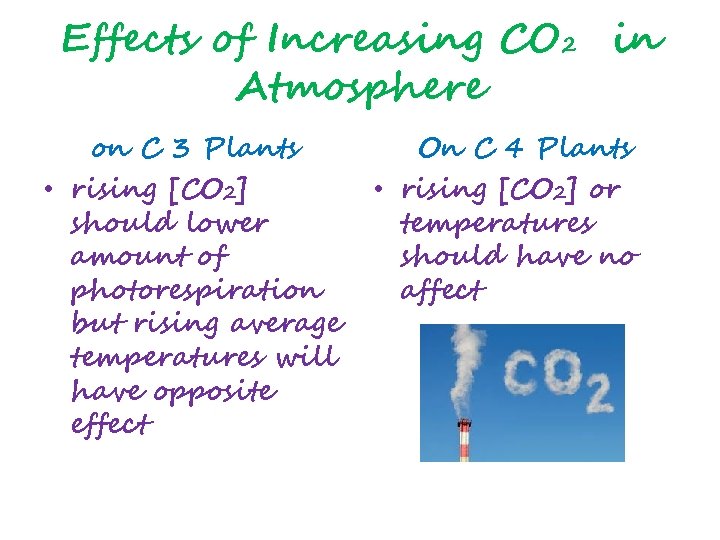
Effects of Increasing CO 2 in Atmosphere on C 3 Plants • rising [CO 2] should lower amount of photorespiration but rising average temperatures will have opposite effect On C 4 Plants • rising [CO 2] or temperatures should have no affect
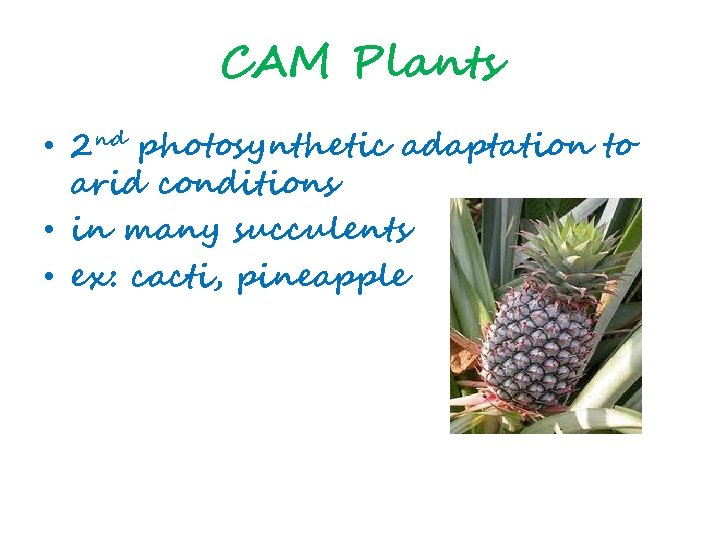
CAM Plants • 2 nd photosynthetic adaptation to arid conditions • in many succulents • ex: cacti, pineapple

CAM Plants • open their stomata during night & close them during day • conserves water and prevents CO 2 from entering leaf • CO 2 enters leaf during night where it is incorporated into a variety of organic acids
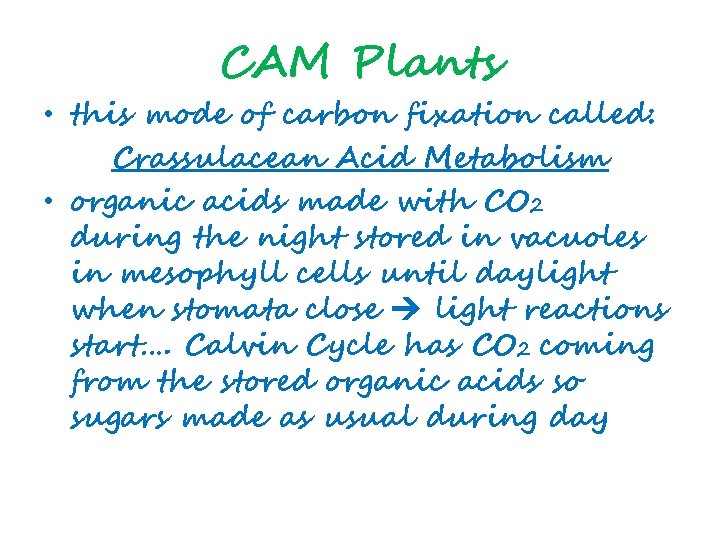
CAM Plants • this mode of carbon fixation called: Crassulacean Acid Metabolism • organic acids made with CO 2 during the night stored in vacuoles in mesophyll cells until daylight when stomata close light reactions start…. Calvin Cycle has CO 2 coming from the stored organic acids so sugars made as usual during day

CAM Photosynthesis
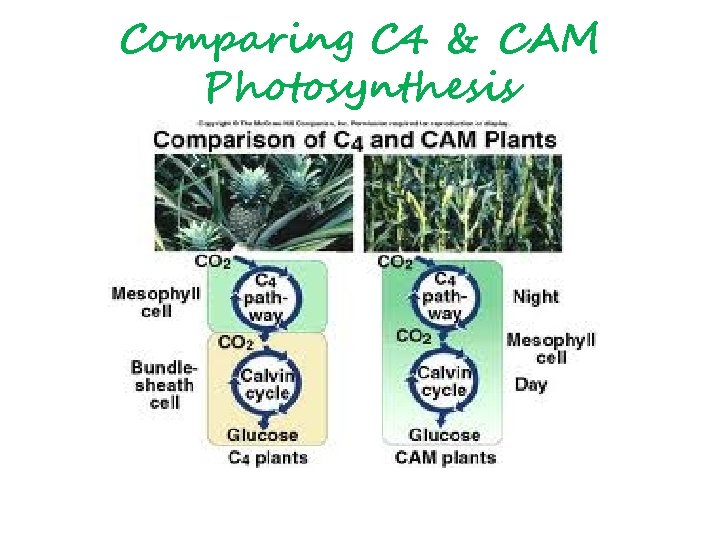
Comparing C 4 & CAM Photosynthesis
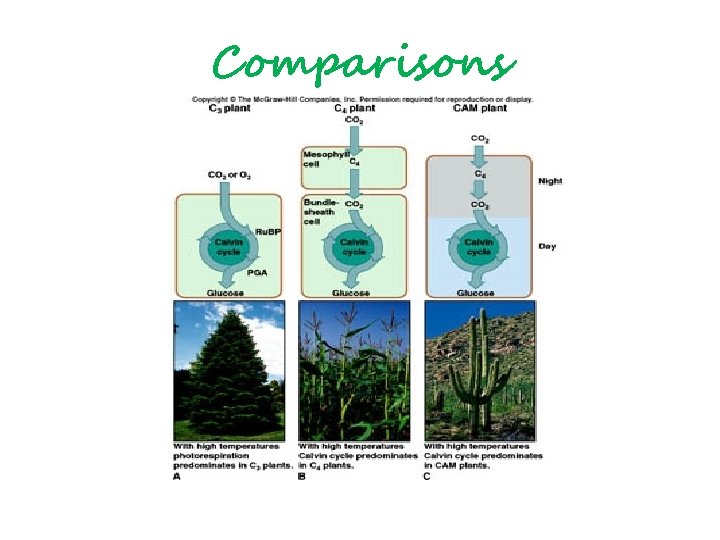
Comparisons


Importance of Photosynthesis • responsible for presence of O 2 in atmosphere • makes an estimated 160 billion metric tons of carbohydrate per year • No other process as important to welfare of life on Earth

Say Thank You to a Plant Today
- Slides: 118